Ijraset Journal For Research in Applied Science and Engineering Technology
- Home / Ijraset
- On This Page
- Abstract
- Introduction
- Conclusion
- References
- Copyright
To Study and Compare Plant-Based Natural Coagulant in Water Treatment
Authors: Tanuja Bhalwe, Revati Powade, Apoorva Hanwate, Amita Dongare, Kamini Khandare, Abhilasha Deshmukh
DOI Link: https://doi.org/10.22214/ijraset.2022.43329
Certificate: View Certificate
Abstract
Water pollution is any chemical, natural, or... Biological change in water quality with adverse effect Influence on anything alive that he drinks, uses, or lives when. Humans drink contaminated water that often has serious effects on humans. It is a removal technique for their health water purification. Undesired chemicals, biological contaminants, suspended the solids and gases of water may reduce water taping. The concentration of a set of dissolved and particle materials Chemical vectors are usually common as iron salts and... Aluminium is used in this commonly used mutant. Aluminium sulphate is known as Alum when added to: Raw water interacts with the dicarbon matches found in Water is a gluten deposition that attracts this factor. Other microparticles and suspended materials in raw water. The liquid settles at the bottom of the container. However, using this process can be costly and may have harmful effects on people if too much is taken. In order to overcome the limitations of conventional coagulants, natural coagulants such as Neem leaves, Tulsi leaves moringa oleifera and tamarind seed powder are used. In this study, the effectiveness of different types of chemical coagulants was compared. Alum was found to be more effective than natural coagulants such as Neem leaves, Tulsi leaves, moringa oleifera and tamarind seed powder. The maximum turbidity reduction of alum, moringa oleifera, tamarind, Tulsi leaves, Neem leaves was found to be 97.2%, 92.8%, 70.34%, 72.54%, 65.89%. Using a locally available natural coagulant was found to be suitable, easier, and cheaper than using more traditional methods, and it was also more environmentally friendly.
Introduction
I. INTRODUCTION
A. General
Water is essential for all lifeforms, and it drives all activity in nature. Water is vital and development in all parts of the world. The availability of Sufficient water supply, both in terms of quantity and Quality is essential for human existence. Civilization Developed around waters that could support Agriculture, transport and drinking water. Recognition of the importance of water quality Slowly developed.
Early humans relied on their physical senses of vision, taste and smell to judge water quality. Not applicable Up to biological, chemical and medical science Methods for measuring water quality have been developed and determine their impact on human health and well-being. Water pollution is the presence of some inorganic, organic, Biological, radiological or physical foreign material Water that tends to deteriorate its quality. Normally, water is not pure in a chemical sense. The water contains contaminants of various kinds, both dissolved and suspended. The polluted water is cloudy, unpleasant, bad smelling, and unsuitable for drinking, bathing, or washing.
Water pollution is caused by the presence of pollutants and pathogens beyond certain limits. most of Pollution is caused by human activities such as emissions Sewage, wastewater and waste from households and industries Plants, particulate matter and metals and their Due to mining and metallurgy, fertilizers and Pesticide runoff from agricultural activities. Water needs to be treated to prevent it from becoming a waste. The chemical coagulants, such as salts of iron and aluminium, are commonly used. Aluminium sulphate is a commonly used coagulant. When it is added to raw water, it reacts with the bicarbonate alkalinities present in the water and forms a gelatinous precipitate. This floc material is attracted to other small particles and water droplets in raw water, and will eventually settle to the bottom of the container. However, this process is expensive and can also have harmful effects if taken in too much. In order to overcome these limitations, natural coagulants such as moringa oleifera tamarind seed powder Tulsi leaves and Neem leaves are used. The use of Moringa and tamarind seeds, Neem and Tulsi leaves has an added advantage over the chemical treatment of water because it is biological and has been reported as edible, eco-friendly, economical, and locally available.
B. Scope
Modern wastewater treatment is intended to: Cost-effective, economical, natural and simple integration. In conventional water treatment, coagulation is achieved. Using chemical insects such as aluminium sulphate, Ferric Chloride, polyalanine chloride etc. at the time that: The effectiveness of these catalysts is well known. However, they began to apply in water treatment. Ineffectual due to in effectiveness at low temperature. Water, relatively high purchase costs, adverse effects. In human health, large bath sizes are produced. The fact that it significantly affects the Hs of treated water. It is therefore necessary to make an in-depth study of the fermentation activity of these seeds is moringa Oleifera, Tamarind seeds, Tulsi and Neem leaves to assess the optimal dose. In order to remove maximum solidity, pH, acids, and alkaline. Reducing the content of chloride.
C. Coagulation
Coagulation is a treatment method for polluted water. It entails adding chemicals or natural items to water, which alters the physical state of dissolved and suspended solid particles in the water, making sedimentation or flocculation easier.
D. Chemical coagulant
The chemicals used in wastewater treatment include alum, ferric chloride, ferric sulphate, ferrous sulphate, and lime. These compounds react with the more difficult-to-settle-down particles, introducing positive charges that destabilise the particulates' negative charges. As a result, sedimentation or flocculation, in which polymers adsorb onto the particulates and cause them to clump together into clumps called "flocs," can readily remove these particles merging into a settled form. These compounds react with the more difficult-to-settle-down particles, introducing positive charges that destabilise the particulates' negative charges.
Natural polyelectrolytes from plants have long been used to remediate sediment-clouded water, usually in the form of powder or paste. Although a large amount of seed can be needed to make a natural coagulant, Moringa Oleifera has been determined to be the finest natural coagulant so far and can be used in place of its chemical equivalent Alum.
Kernels of dried M. oleifera seeds that have been thoroughly pounded in a mortar to produce a somewhat pasty powder and a 2% suspension prepared with distilled water flocculation (where polymers adsorb onto the particulates, causing them to combine into clumps called "flocs") can be used to make a very simple natural coagulate.
E. Objectives
- To describe the collected water sample.
- To use Moringa oleifera and Tamarind seed as natural coagulants, an alternative to chemical coagulants.
- To treat samples by a natural or chemical coagulant.
- To investigate the dosage of moringa oleifera and tamarind seed powder needed to reduce turbidity of wastewater.
- To study the coagulation efficiency of natural and chemical coagulants in the collected sample of water.
- To make comparative study with conventional chemical coagulants, one may use less conventional coagulants.
F. Materials
- Moringa Oleifera Seed Powder: M.O seeds powder can be used as a natural coagulant. Moringa oleifera seeds are harvested when they are fully mature, their wings and coat are removed, and the seeds are powderized.

2. Tamarind Seed Powder: The seed kernel powder from tamarind fruit is a good agent for making wastewater clear. Currently, aluminium salt is used to treat water with a high chloride concentration. It has been found that alum can increase toxic metals and ions in treated water, and this could lead to diseases like Alzheimer's. Kernel powder is not toxic and can be biodegraded.

3. Tulsi leaves & Neem Leaves: Tulsi can be used as a purifying agent. Basil leaves can help to purify water. Put some Tulsi leaves in a PET container filled with water that is contaminated. Keep the sun about six hours. The sun's ultraviolet radiation can kill the pathogens in the water. The leaves of Turkey take care of the dirt of the sediment. Neem leaves can do the same job as tulsi leaves; However, there is a difference in the fact that tulsi leaves add a sweet scent to the water, but neem leaves can make the water taste bitter.
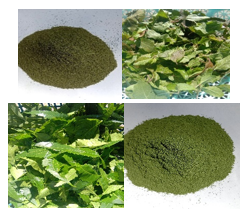
4. Alum: When aluminium sulphate is added to raw water, it reacts with the bicarbonate alkalinity present in the water and forms a gel-like precipitate. This floc is attracted to other small particles and liquid material in raw water and settles to the bottom of the container.
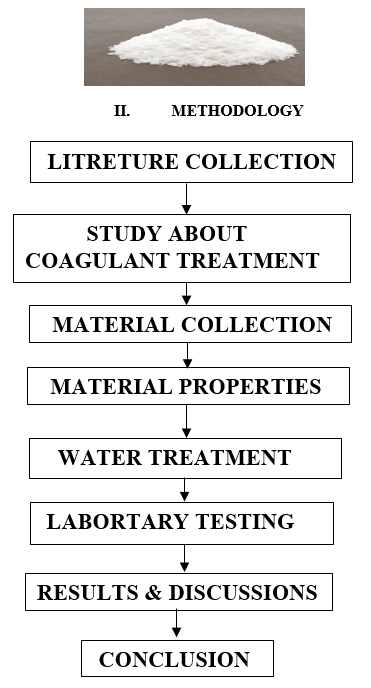
III. EXPERIMENTAL SETUP
The raw waste water sample was analysed for physical parameters, such as turbidity content.
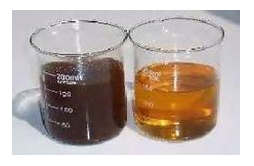
IV. EXPERIMETAL PROCEDURE
- Samples of raw water filled with tanks (500 or 1,000 ml) - 4 jar.
- Add the desired amount of the selected coagulant to each jar, and mix at 100 to 150 rpm for 2 minutes.
- The rapid mix will help to disperse the coagulant throughout each container, and reduce the stirring speed to 11 to 20rpm for 25 to 30min.
- Turn off the sound. And the flock can be stable for 50 to 60 minutes.
- Then measure the final turbidity in each jar.
V. RESULT AND DISCUSSION
In this study, the optimum dosage of a coagulant was determined for moringa oleifera, tamarind seed, tulsi & neem leaves and alum. It was found that the turbidity of wastewater decreases as the concentration of coagulant increases. The optimum concentration was determined by using jar tests. The jar test is an easy experiment that can help determine the optimum coagulant dose required for a particular task.
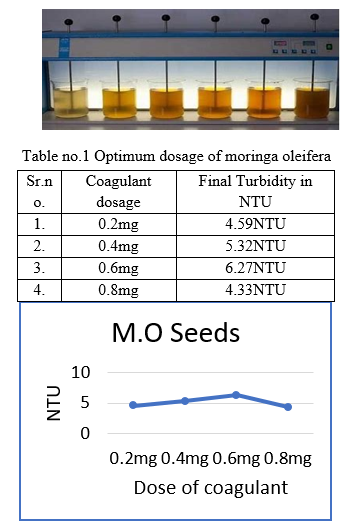
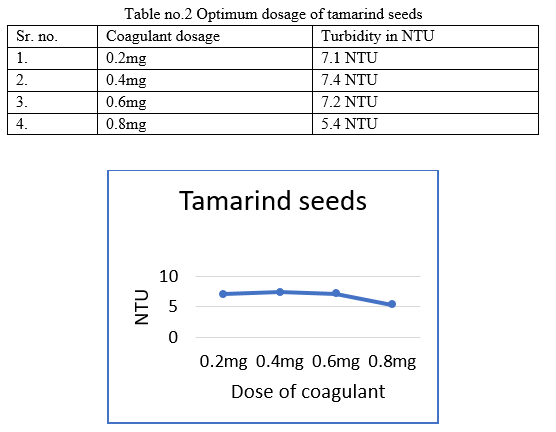
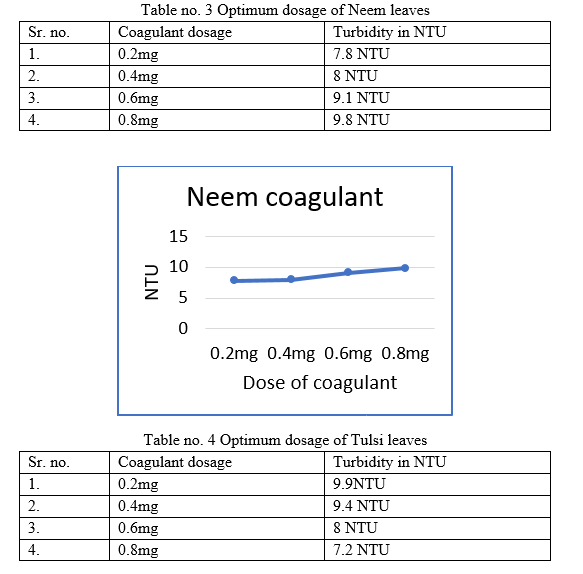
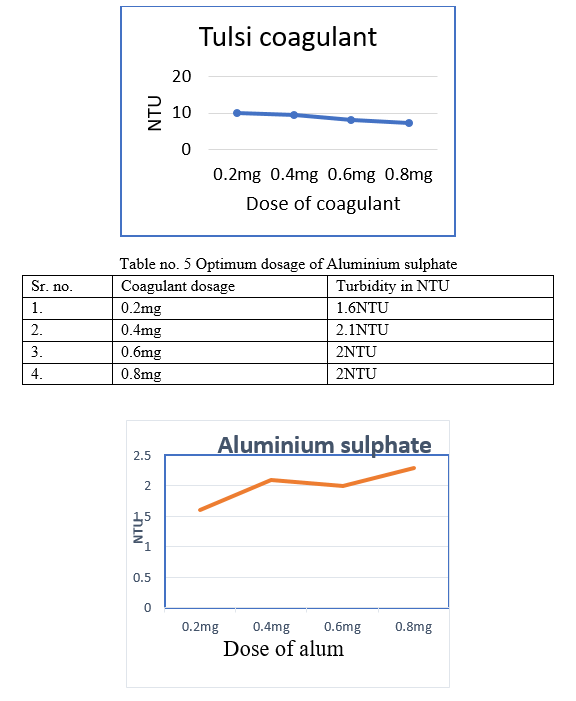
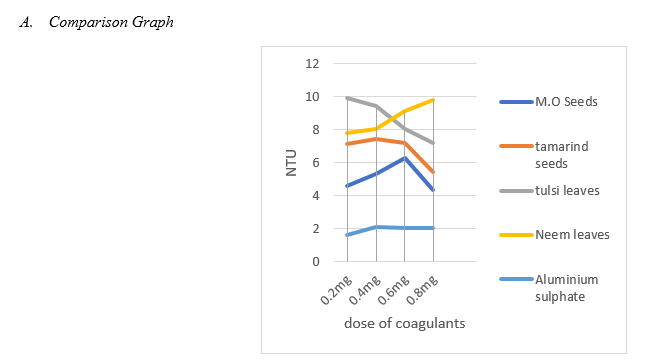
Conclusion
Water is one of the most important natural resources. The high turbidity of wastewater poses a big problem for wastewater treatment. In this study, different types of coagulants were compared to see which is most effective. Alum was compared to natural coagulants such as moringa oleifera, tamarind seed powder, Tulsi & Neem leaves. The maximum reduction in turbidity was achieved with the use of alum, moringa oleifera when combined at a dosage of 1000mg/L respectively. pH, alkalinity, in the treated sample, the acidity and the total amount of chlorides were determined coagulants, and the maximum recovery efficiency was found in use of moringa oleifera. The use of a local natural coagulant was found to be suitable, easier, cheaper, and environmentally friendly for water treatment.
References
[1] Ranke Ruth Ayangunna1, “Coagulation-Flocculation Treatment of Industrial Wastewater Using Tamarind Seed Powder, International Journal of Chemtech Research, Vol.9, 2016 [2] Prof. Chid Anand Patil1, Ms. Manichaean, “Treatment of dairy wastewater by natural coagulants”, International Research Journal of Engineering and Technology (IRJET), volume-2, july-2015 [3] Lukmanaliyu1, Mukhtar L.W2, S.I Abba, “Evaluation of Coagulation Efficiency of Natural Coagulants (Moringa Oleifera, Okra) And Alum, For Yamuna Water Treatment”, International conference of science, technology and management. 27th September 2015. [4] Meenakshi M, et al, “Performance Assessment of Moringa oleifera in clarification of surface water”, International Journal of chemtechResearch, Vol.2, 2015 [5] Ramaiah Walter Otunyo and Arthur N. Okocha, “Moringa Oleifera seed powder as a water coagulant for purification of fresh, rain and borehole water”, International Research Journal of Engineering and Technology (IRJET), volume-4, july-2016. [6] Airmail, et al, “A comparative study on the treatment of turbid water using Moringa oleifera and Alum as coagulant”, International Research Journal of Engineering and Technology (IRJET), volume-4, july-2017. [7] Patil Rohan R, ital., “Use Moringa oleifera seed as natural coagulant for well and bore well water treatment”, International Research Journal of Engineering and Technology (IRJET), volume-4, july-2017. [8] Mohammed Sulaiman, “Moringa oleifera seed as alternative natural coagulant for Potential application in water treatment: A review”, Journal of Advanced Review on Scientific Research 30, Issue 1 (2017) 1-11 [9] Basavanagouda A Patil, “Working Model of Water Treatment Plant Using Moringa Oliefera”, International Journal of Engineering Research-Online, Vol.5., Issue.3, 2017 May-June [10] C.P. pies, Rd. S.A. Hulked. \"A New technique for purification of water using natural coagulant\", International journal of engineering and technology, Vol.6, Dec 2014- Jan 2015 [11] Villamizar FE, Due CN, Ezekannagha CB, Nabes HO. \"Performance Evolution O Moringa Oliefera Seed Powder in Surface Water Treatment and Its Coagulation Kinetics\", Journal of multi-disciplinary Research and development. Vol.4, Jan 2017. [12] Suresnarayasamy, halimimohdsaud, Water Sedimentation using Moringa oleifera Seed Powder to Remove Water Turbidity in Malaysia, Journal of Agricultural Chemistry and Environment, 2014.vol.3 [13] Choy, S. Y., Prasad, K. M. N., Wu, T. Y., Raghu Nandan, M. E., & Ramanan, R. N. (2014). Utilization of plant-based natural coagulants as future alternatives towards sustainable water clarification. Journal of Environmental Sciences (China), 26(11), 2178–2189. [14] Hammer, M.J. and Hammer, Jr. M.J. (2004). Water and Wastewater Technology In: Wastewater Processing. (5th ed). Pearson Prentice Hall: Ohio. [15] Fascinate, N., & Nithyanandam, R. (2014). Wastewater Treatment by using Natural Coagulant. 2nd Eureka, 2–3. [16] Kristian to, H. (2017). The Potency of Indonesia Native Plants as Natural Coagulant: a Mini Review. Water Conservation Science and Engineering, 2(2), 51–60. [17] Boltro, B., & Gregory, J. (2007). Organic polyelectrolytes in water treatment, 41, 2301–2324. [18] Tripathy, T., & De, B. R. (2006). Flocculation: A New Way to Treat the Waste Water, 10, 93–127. [19] Ola Doja, N. A. (2015). Headway on natural polymeric coagulants in water and wastewater treatment operations. Journal of Water Process Engineering, 6, 174–192. [20] Liu, Z., Huang, M., Li, A., & Yang, H. (2017). Flocculation and antimicrobial properties of a actionized starch. Water Research, 119, 57–66. [21] Choy, S. Y., Prasad, K. N., Wu, T. Y., Raghu Nandan, M. E., & Ramanan, R. N. (2016). Performance of conventional starches as natural coagulants for turbidity removal. Ecological Engineering, 94, 352–364. [22] Choy, S. Y., Prasad, K. M. N., Wu, T. Y., Raghu Nandan, M. E., Yang, B., Phung, S. M., & Ramanan, R. N. (2017). Isolation, characterization and the potential use of starch from jackfruit seed wastes as a coagulant aid for treatment of turbid water. Environmental Science and Pollution Research, 24(3), 2876–2889. [23] Yan, S., Murthy, K., Prasad, N., Yeong, T., Eshwaraiah, M., Phung, S., & Ching, J. (2017). Starch -based flocculant outperformed aluminium sulfate hydrate and propylammonium chloride through effective bridging for harvesting acicular microalga Ankistrodesmus. Algal Research, (February), 0–1. [24] Kakoi, B., Kalli, J. W., Ndibe, P., & Thiong’o, G. (2017). Optimization of Mireau Decumbent bio-coagulant in paint industry wastewater treatment with response surface methodology. Journal of Cleaner Production, 164, 1124 –1134. [25] Anju, S. (2016). Exploring the Use of Orange Peel and Neem Leaf Powder as Alternative Coagulant in Treatment of Dairy Wastewater, 7(4), 238–244. [26] Ola Doja, N. A., Salisu, T. D., Olopade, I. A., Anthony, E. T., & Bello, G. A. (2017). A new indigenous green option for turbidity removal from aqueous system. Separation and Purification Technology, 186, 166 –174. [27] Muthu Raman, G., & Shashikala, S. (2014). Removal of turbidity from drinking water using natural coagulants. Journal of Industrial and Engineering Chemistry, 20(4), 1727 –1731. [28] Takaoka, A., Baptista, A., Oliveira, M., Guttierres, R., Bergamasco, M., Fernandes, M., Vieira, S. (2017). Protein fractionation of seeds of Moringa oleifera lam and its application in superficial water treatment. Separation and Purification Technology, 180, 114 –124. [29] Camacho, F. P., Sousa, V. S., Bergamasco, R., & Ribau Teixeira, M. (2017). The use of Moringa oleifera as a natural coagulant in surface water treatment. Chemical Engineering Journal, 313, 226 – 237. [30] Garde, W. K., Buchberger, S. G., Wendell, D., & Kupferle, M. J. (2017). Application of Moringa Oleifera seed extract to treat coffee fermentation wastewater. Journal of Hazardous Materials, 329, 102 –109.
Copyright
Copyright © 2022 Tanuja Bhalwe, Revati Powade, Apoorva Hanwate, Amita Dongare, Kamini Khandare, Abhilasha Deshmukh. This is an open access article distributed under the Creative Commons Attribution License, which permits unrestricted use, distribution, and reproduction in any medium, provided the original work is properly cited.

Download Paper
Paper Id : IJRASET43329
Publish Date : 2022-05-26
ISSN : 2321-9653
Publisher Name : IJRASET
DOI Link : Click Here
 Submit Paper Online
Submit Paper Online

